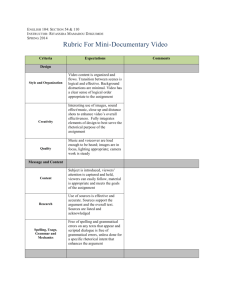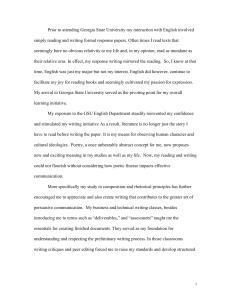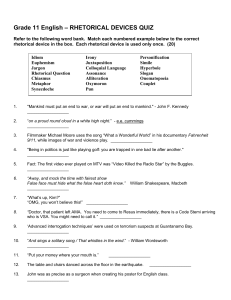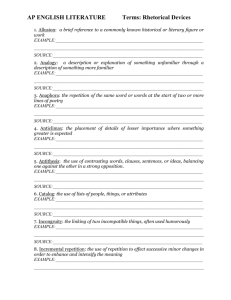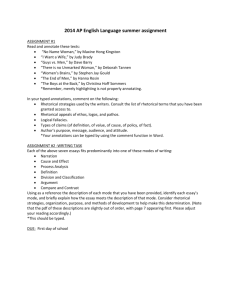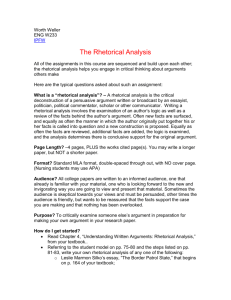INTRODUCING RHETORICAL STRATEGIES
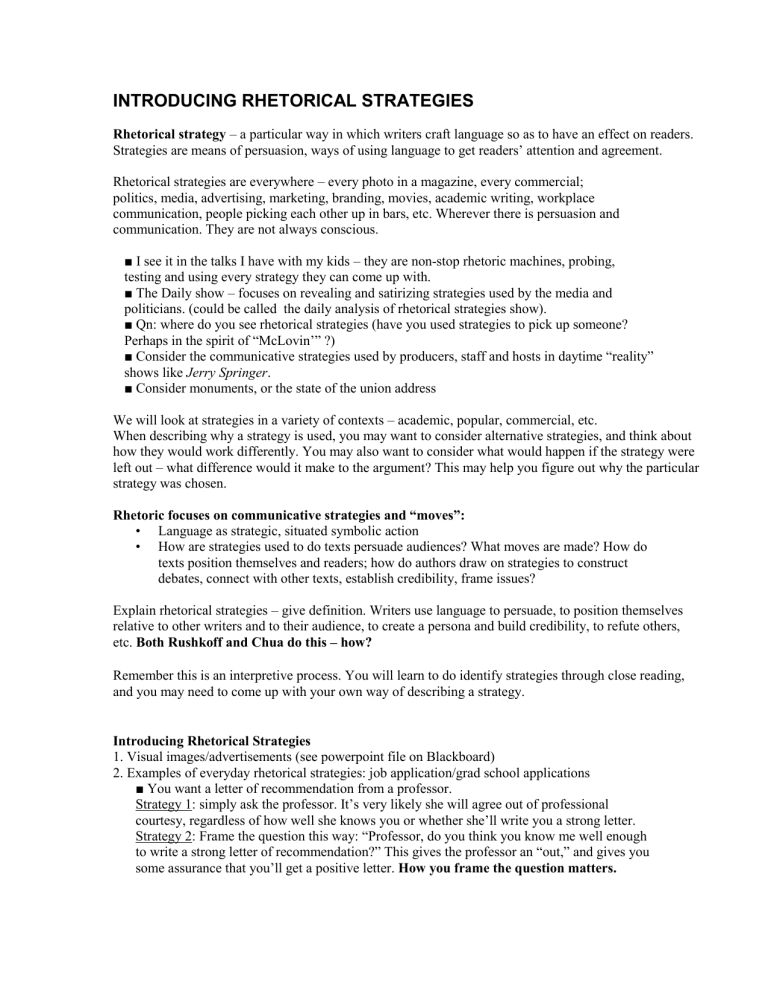
INTRODUCING RHETORICAL STRATEGIES
Rhetorical strategy – a particular way in which writers craft language so as to have an effect on readers.
Strategies are means of persuasion, ways of using language to get readers’ attention and agreement.
Rhetorical strategies are everywhere – every photo in a magazine, every commercial; politics, media, advertising, marketing, branding, movies, academic writing, workplace communication, people picking each other up in bars, etc. Wherever there is persuasion and communication. They are not always conscious.
■ I see it in the talks I have with my kids – they are non-stop rhetoric machines, probing, testing and using every strategy they can come up with.
■ The Daily show – focuses on revealing and satirizing strategies used by the media and politicians. (could be called the daily analysis of rhetorical strategies show).
■ Qn: where do you see rhetorical strategies (have you used strategies to pick up someone?
Perhaps in the spirit of “McLovin’” ?)
■ Consider the communicative strategies used by producers, staff and hosts in daytime “reality” shows like Jerry Springer .
■ Consider monuments, or the state of the union address
We will look at strategies in a variety of contexts – academic, popular, commercial, etc.
When describing why a strategy is used, you may want to consider alternative strategies, and think about how they would work differently. You may also want to consider what would happen if the strategy were left out – what difference would it make to the argument? This may help you figure out why the particular strategy was chosen.
Rhetoric focuses on communicative strategies and “moves”:
• Language as strategic, situated symbolic action
• How are strategies used to do texts persuade audiences? What moves are made? How do texts position themselves and readers; how do authors draw on strategies to construct debates, connect with other texts, establish credibility, frame issues?
Explain rhetorical strategies – give definition. Writers use language to persuade, to position themselves relative to other writers and to their audience, to create a persona and build credibility, to refute others, etc. Both Rushkoff and Chua do this – how?
Remember this is an interpretive process. You will learn to do identify strategies through close reading, and you may need to come up with your own way of describing a strategy.
Introducing Rhetorical Strategies
1. Visual images/advertisements (see powerpoint file on Blackboard)
2. Examples of everyday rhetorical strategies: job application/grad school applications
■ You want a letter of recommendation from a professor.
Strategy 1: simply ask the professor. It’s very likely she will agree out of professional courtesy, regardless of how well she knows you or whether she’ll write you a strong letter.
Strategy 2: Frame the question this way: “Professor, do you think you know me well enough to write a strong letter of recommendation?” This gives the professor an “out,” and gives you some assurance that you’ll get a positive letter. How you frame the question matters.
■ You are in a job interview. It’s a common genre. They will ask you about your strengths, and will also ask about weaknesses. What do you do? A) dress up a strength as a weakness (I work too hard; I’m a perfectionist; I have overly exacting standards; etc.) B) irrelevance (I’m not that great at X, where X isn’t really part of the job – e.g. sales in engineering position. C)
Something trivial, yet being worked on (I’m not great at X, where X isn’t very important, and you say I’m working hard on it.)
CONNECTION – presidential debates – how do you answer if you are a democrat/republican? E.g. Clinton stated “believing the president when he said he would go to the United Nations and put inspectors into Iraq to determine whether they had WMD.”
Biden: “overestimating the competence of this administration and underestimating the arrogance.” Brownback: “I don't tell my wife and kids I love them enough?” Tancredo: “I took too long to realize Jesus was my personal savior.” Romney: he “was pro-choice,” but switched to a “pro-life” position as governor of Massachusetts.
■ Section of job interview where they ask if you have any questions – what questions would you ask? (Something that shows you know about the organization, are clued up, or that show you take the position seriously – possibility for professional development, learning, etc.
3. Headlines & framing
4. Ask about Chua – what rhetorical strategies might be involved in choosing to start with the story about her aunt’s death? Why start with this? Why not start with statistics about killings of market dominant minorities?
5. Other examples
Terms & categories: War on terror (struggle against terrorist extremists); Vietnam war:
(insurgency in South East Asia, civil war in south east Asia, or imperialism in south east Asia.
Global Warming/Climate Change; doctor assisted suicide (death with dignity euthanasia), etc.
Metaphors, Tropes, Word Choice
Use of narrative and framing etc.
This is an interpretive process – no rigid formula – must engage in close, critical reading, careful viewing, and analysis
■ Understanding rhetorical strategies is part of moving from a focus on what texts say (content) to what they do and how they do it (rhetoric). Rhetorical self consciousness = achieving a kind of double vision – of looking “at” as well as through language.
This can be conscious and unconscious
Reframing Organizations (Bolman and Deal): metaphors for organizations often divide up into 4 types: structural, symbolic, political, and human resources (Factory, Family, Jungle, Temple)
Metaphors that may “think for us” (from Lakoff & Johnson)
1.
Spatial Metaphors
The foot of the bed, the foot of the hill, the back of the house, the face of the mountain, the leg of the chair, the skin of the orange, etc.
2.
Metaphors for Arguments
Your claims are indefensible…I attacked the weak points in his argument…She couldn’t counter my criticisms…his criticisms were on target…she won the argument…his position is strong…his argument lacked support
3.
Life/Career
He saw no way of getting ahead. He felt he was falling behind. Where do you want to be in 5 years? His career path was working out well. She felt her life was finally on the
right track. He was approaching his forties. Things were going well (note how the auxiliary verb “go” is often used to indicate the future, as in “I’m going to be a lawyer.”)
[Life is a journey (the person is a traveler, purposes are destinations, means are routes, difficulties are obstacles, counselors are guides, achievements are landmarks, choices are crossroads]
4.
Knowledge & Understanding
I see what you are saying (cf. “savoir” in French). She showed great insight. My view of this issue is…what is your outlook on the problem? The concept was clear to her.
For example – consider the following terms – they describe, but they also “order” the world in particular ways, and construct a certain perspective on things:
Weed
Social anxiety disorder
Male pattern baldness [medicalizes an aspect of aging]
Halitosis [makes condition sound scarier?]
Gastro Esophageal Reflux Disease (GERD)
Erectile Dysfunction (ED) [makes condition sound less embarrassing?]
Negro, Black, African American
Freedom fries
Each of these is a way of framing and constructing the world, and each involves questions of rhetoric, perspective and strategy.
• Understanding rhetorical strategies is an important skill. Revealing the rhetorical moves that writers make, the strategies they draw on, is part of achieving academic literacy, and of acculturation into disciplinary communities. When you recognize the moves you not only understand the disciplinary conversation better, you are better equipped to join it.
Advertisements and rhetorical strategy : a basic strategy is association – the repeated juxtaposition of two qualities in a strategic way so as to transfer the meaning of one thing to another. E.g. Beer + sexy girls, or Beer + fun times with buddies. This strategy (aka
“conditioning”) was developed in psychology and adapted to advertising.
Consider this video: http://www.youtube.com/watch?v=Al9GJifHC9s&feature=related
(conditioning = 4 minutes. 5.30 = Pavlov. NOTE strategies of video itself – sexy woman with cleavage, sitting in leather chair with books around.)
- John Watson & Baby Albert. Watson uses principles of behaviorism in advertising.
- Associations can become powerful – and we are often less aware them than we think, or of how successful these strategies have been. Consider, diamonds and weddings and love (and De
Beers) 1 ; the Coca Cola bottle; Santa as fleshy icon of consumption dressed in red and white , etc.
1
Since 1940, DeBeers' brilliant ad campaign has convinced Americans that diamonds mean love.
According to Bob Garfield of Advertising Age magazine, the DeBeers campaign is one of the most effective ad campaigns of all time. "It created out of whole cloth the notion that at your engagement you must give your intended a diamond." It is a recent tradition. DeBeers cleverly lends diamonds to celebrities and movie stars, and specifies how much men should spend.
■ What are some of the rhetorical strategies you’ve noticed in advertising?
(repetition, imprinting on memory – jingles, rhyme [Gillette, the best a man can get], humor, shock) social acceptance, sex, fear, etc.)
FRAMES, CATEGORIES, DEFINITIONS, AND METAPHOR
“Are we not coming to see that the whole works of scientific research, even entire schools, are hardly more than the patient repetition, in all its ramifications, of a fertile metaphor? Kenneth Burke,
Permanence & Change”
Rhetorical strategies can be identified in the ways authors create frames, choose categories and metaphors, and construct definitions.
Frames are typically constructed through the use of metaphors, definitions, narratives, categories and metalinguistic commentary. They are used to get an audience to attend to certain elements of a situation and ignore others; to construct a particular way of seeing an issue, event, person or group, and to shape the way an audience understands the context of communication. They can have persuasive effects. To identify:
1)
Look for the “root” metaphor in an argument (the “God term,” Burke) and the
“entailments” the metaphor constructs. This will often tell you much about the frame/conceptual logic governing an argument. Look for the interests, silences, ideologies and values identifiable in particular uses of metaphor. Example: The
“desktop” metaphor could perhaps be thought of as the “root” metaphor for much personal computing. It is used to organize information in terms of files, file folders, a trash can, etc.
2)
Identify a cluster or network of related metaphors and examine the “entailments” this constructs
3)
Examine how a particular metaphor is “inflected,” appropriated and contested by opposing interests. This can help you understand the ways in which cultural and political struggle are mediated in language.
4) Examine shifts in metaphors that occur over time. This can tell you a lot about how an object or event is being constructed and framed, and the forces, actors, and ideologies at play in that construction.
5) Consider how some new object of event is captured in metaphor; how metaphors can function as creative resources in imagining new visions of an object or event, or as a creative resource in constructing new knowledge.
CONSIDER – Names, Categories & Definitions as Strategic.
Viagra (why name it that – what does the sound of the name connote?)
Department of defense/war
War on drugs
Axis of Evil
War on Terror
Collateral Damage
Body bag/transfer tube
Department of Corrections
“The Patriot Act” – why this name for a piece of legislation?
(P.A.T.R.I.O.T =
“Providing Appropriate Tools Required to Intercept and Obstruct Terrorism Act”)
[It’s about revising civil liberties in relation to new security threats, and new forms of government surveillance – it’s thus potentially a very sensitive issue.])
Homeland Security (vs. National Security – pathos?)
Doctor assisted suicide
Vietnam War/Insurgency in South East Asia/American Imperialism in Asia
Conflict in Iraq = insurgency, civil war, terrorism, occupation, all of the above?
Rape – in the past, there was a question about its definition as related to being inside marriage or not – where do we draw the line around a set of actions or entities? Why and how does the line shift?
“The economy shed 5000 jobs last month”
REBUTTALS
Rebuttals as rhetorical strategies - example: consider rebuttals as a strategy to anticipate and “inoculate” the reader against competing claims; to seem “fair and balanced”; to use contrast – show what against in order to clarify what you are for; to join a conversation, position oneself within a community, and claim a position in a community.
What do academic articles and telemarketing scripts have in common? Rebuttals!
Here is a standard template for telemarketing:
Pre-introduction : (Ask to speak to the decision-maker)
Introduction : (Introduce yourself and the reason for your call)
Attention Getter : (Mention the key features of the offer and qualify them for eligibility)
Probing Questions : (Always ask for information that will be useful for rebuttals)
Offer : (Explain the product/service and terms of commitment)
Close : (ALWAYS ASK FOR THE SALE)
Rebuttal (deal with objections)
Sales Continuation : (Agree, use rebuttals, sell benefits, CLOSE)
Up/down/cross-sell : (If there is another product of less-price this is the time to sell it.)
Confirmation Close : (Review the terms of the offer to reduce buyer remorse)
Final Close : (End on a positive note. Thank the customer and leave a dial free number for customer support)
Telemarketing Rebuttals
A telemarketing ploy you may have experienced is the offer of a “free trip” which requires that you take a brief tour of a resort which turns into a high pressure sale of a timeshare. Here is an excerpt from a website that describes the argumentative strategies used:
Phase three is what telemarketers refer to as overcoming objections with rebuttals. Rebuttals are basically responses for every possible objection the telemarketer might receive. The telemarketer literally breaks objections into three categories: spousal, credibility, and time-off-work . For a spousal rebuttal the telemarketer will say things like 'why don't you surprise you wife or husband with a free getaway?', or 'doesn't your family deserve to get away ?,' or a defensive tactic 'aren't you allowed to make decisions?
' This is usually said if a male answers the phone. The longer the telemarketing agent can keep someone on the phone without hanging up, the more likely they will get someone to agree to the trip… the most common objection is not being able to get off work.
This is when the telemarketer would say if we could fit this vacation in with your schedule would you take it?
The purpose of the rebuttal is to reduce the objection down to just one problem.
(http://www.funandsun.com/vacations/ripoffs.html)
Note – leading questions (pack question with assumptions and values. “Have you stopped beating your girlfriend yet?”)
Telemarketers – don’t you think you and your family deserve a free vacation?
You work hard, don’t you?
Etc. See used by politicians and media all the time. Why do you oppose the liberation if Iraq? Why do you refuse to support our troops? See cable news.
SEE in commercials – “wouldn’t you like to feel better, have more energy…”
QUALIFICATION
– clarifying the degree, scope and strength of an argument, and specifying exceptions and limits. The more qualified a position is, the less likely it is the author sees things in black and white. Qualifications adds shades of gray.
1.
Claim : Since the U.S. leads the world in gun deaths, tighter restrictions on gun ownership should be applied.
Evidence : 11,000 people were killed from guns last year, and many thousands more were killed as a result of accidents and suicide. This is more than any other country.
Warrant #1 : tightening access to guns will reduce the number of murders and gun-related deaths
Warrant #2 : in England and Australia, where gun laws are more restrictive, very few people are killed with guns. If we had similar laws we would reduce the number of gun deaths.
Backing: in England, where background checks, licensing and registration are mandatory, and where access to hand guns is more restrictive, 30 times fewer gun deaths per capita were reported in the 1990s than in the U.S.
QUALIFICATION : this is not to suggest that guns should be banned, or that law abiding citizens should stop being able to purchase firearms, or that the 2 nd amendment should not be adhered to.
It is merely to suggest that background checks, waiting periods, licensing and training should be more strictly regulated and enforced.
Rebuttal : opponents will claim that guns don’t kill people, people kill people. This is true, but overlooks the fact that A) guns enable killing on a scale and speed that few other everyday objects provide. For example, while knives can kill, there has never been a “drive by stabbing.” B) Death from accidental shootings, suicides and “crimes of passion” are much more likely to occur with guns than with other weapons. Thus while it may take a person to kill another person, a gun enables this in a way that other easily accessible technologies do not.
What is the purpose – what do qualifications achieve?
They add accuracy, precision, and nuance to a claim. They clarify an author’s position, and make misinterpretation less likely. With some contexts/audiences they can be a problem (make you seem too
“cerebral,” afraid to take a clear stance, etc.).
■
Watch this excerpt from Thank you for Smoking – what strategies do you see? [Nick
Naylor reframes the debate, gives a crafty rebuttal, and engages in metacommentary (he speaks to the camera). Consider: http://www.youtube.com/watch?v=4HC3xwlfcFM
■
Can you find rebuttals and qualifications in Sicko?
[Sicko is structured in large part around rebuttals – but in a fairly general form (perhaps almost in straw man form). Sicko does not contain much qualification of claims.
■ What strategies can you identify in Sicko?
Frames & Framing
Frames are constructed through the use of metaphors, definitions, narratives, categories and metalinguistic commentary. They are used to get an audience to attend to certain elements of a situation and ignore others; to construct a particular way of seeing an issue, event, person or group, and to shape the way an audience understands the context of communication.
E.g. framing the way you construct your request for a letter of recommendation.
E.g. how we order the journalist’s “What, Where, Who, How, Why” creates a frame.
(1. Act 2. Scene 3. Agent 4. Agency, 5. Purpose)
Example : Katrina. How do we frame what happened? What importance do we give to the scene/context (where it happened)? What role did the chief actors play in the event? What elements had the greatest agency/by what means did they act? Why did they act the way they did?
Example
: how do we frame the homeless problem, and what “ratio” do we set up (what weight do we give one element of pentad over others?)
AMERICAN BEAUTY & FRAMING : the start and end contain voice-overs that frame the events and provide us with a lens on the entire movie. Lester Burnham’s narration tells us what to expect at the start, and how to interpret what has happened at the end.
FRAME [ Kevin Spacey, providing us voice-over narration ] “My name is Lester Burnham. This is my neighborhood; this is my street; this is my life. I am 42 years old; in less than a year I will be dead. Of course I don't know that yet, and in a way, I am dead already. [As the camera slowly prowls though a bathroom, we find Lester taking a hot shower]…Look at me, jerking off in the shower — this will be the high point of my day. It's all downhill from here…That's my wife, Carolyn. See the way the handle on her pruning shears matches her gardening clogs? That's not an accident….Janie's a pretty typical teenager. Angry, insecure, confused. I wish I could tell her that's all going to pass, but I don't want to lie to her…Both my wife and daughter think I'm this gigantic loser and they're right, I have lost something. I'm not exactly sure what it is but I know I didn't always feel this... sedated . But you know what? It's never too late to get it back.”
Lester Burnham : [ narrating ] I had always heard your entire life flashes in front of your eyes the second before you die. First of all, that one second isn't a second at all, it stretches on forever, like an ocean of time... For me, it was lying on my back at Boy Scout camp, watching falling stars... And yellow leaves, from the maple trees, that lined my street... Or my grandmother's hands, and the way her skin seemed like paper... And the first time I saw my cousin Tony's brand new Firebird... And
Janie... And Janie... And... Carolyn. I guess I could be pretty pissed off about what happened to me... but it's hard to stay mad, when there's so much beauty in the world. Sometimes I feel like I'm seeing it all at once, and it's too much, my heart fills up like a balloon that's about to burst... And then I remember to relax, and stop trying to hold on to it, and then it flows through me like rain and I can't feel anything but gratitude for every single moment of my stupid little life... You have no idea what
I'm talking about, I'm sure. But don't worry... you will someday.
http://www.dailymotion.com/video/x2ijc7_american-beauty-fly_family
METACOMMENTARY (AKA METADISCOURSE)
A Common Rhetorical Strategy: Metacommentary
■ Moments in the text where the author explicitly TELLS you how to interpret her words
(rather than SHOWING.)
■ In academic arguments, it’s where the author stops arguing, and stands back and tells you how to interpret his argument – where he reflects on what he is doing. And he may make explicit strategies (it’s the strategy of explaining your strategy). (YOUR project statement in the introduction is like this).
Practicing writing metacommentary is useful – it helps you develop your ideas, generate more text, and get a better sense of both your paper’s structure and how you might change direction. In clarifying things for your reader you do so for yourself, and in making explicit where you are going, you may see other paths. See I Say p. 126-30.
Metacomentary is often used to:
1.
Ward off potential misunderstandings.
2.
Anticipate and respond to objections.
3.
Forecast & review structure/purpose (provide a roadmap)
4.
Alert readers to an elaboration of a previous idea.
5.
Move from a general claim to a specific example.
6.
Indicate that a claim is especially important
7.
Indicate where the “gap” is in a scholarly debate
8.
Indicate the author’s contribution (filling the gap)
Metacommentary as clarification: Chua p 113
The argument I am making is frequently misunderstood. I do not propose a universal theory applicable to every developing country. There are certainly developing countries without market-dominant minorities…Nor do I argue that ethnic conflict arises only in the presence of a market dominant minority…And, last, I emphatically do not mean to pin the blame for any case of ethnic violence – whether the mass killings perpetuated on all sides in the former Yugoslavia or the attack on America – on economic resentment, on markets, or any other single cause…The point, rather is this: In the numerous countries around the world that have pervasive poverty and a market dominant minority, democracy and markets - at least in the raw, unrestrained forms in which they are currently being promoted – can only proceed in deep tension with each other.
Metacommentary as rhetorical strategy
1 . It is my intention in this book to show that a great…shift has taken place in America, with the result that the content of much of our public discourse has become dangerous nonsense.
2.
With this in view, my task in the chapters ahead is straightforward. 3.
I must, first, demonstrate how, under the governance of the printing press, discourse in America was different from what it is now – generally coherent, serious and rational; and then how, under the governance of television, it has become shriveled and absurd. 4.
But to avoid the possibility that my analysis will be interpreted as standard-brand academic whimpering, a kind of elitist complaint against “junk” on television, I must first explain that…I appreciate junk as much as the next fellow, and I know full well that the printing press has generated enough of it to fill the grand canyon to overflowing. 5.
Television is not old enough to have matched printing’s output of junk.
Neil Postman, Amusing Ourselves to Death: Public Discourse in the Age of Show
Business .
Metacommentary in Popular Culture
In fictional texts, metacommentary is where the narrator or a character stands back from the action and addresses the audience – and in some cases tells you what to make of things.
■ FERRIS BUELLER – remixed – it’s the ultimate metacommentary movie. http://www.vimeo.com/148143
■ Fight Club does this – reflects on its own strategies, and even enacts them – splicing in strange stuff. A strategy in movie is to dramatize advertising associations and subliminal messages. AT END – see explicitly – but all through, there are msgs.
FIGHT CLUB & METADISCOURSE http://www.youtube.com/watch?v=jrG6MfRwFUk&feature=related http://www.youtube.com/watch?v=XnQIhJ2fJYk&feature=related
TRAINSPOTTING
PLATOON
Naming, defining, key terms and categories, framing devices, ethos, pathos, logos, rebuttals, qualifications, juxtaposition, analogy, appeals to authority, principle, etc.
■ Qualification
“Drugs should be legalized because people should be free to make choices and fighting the war on drugs does more harm than good.”
“Gun regulations should be done away with. If everyone had a gun, criminals would be less likely to brandish them and tragedies such as Columbine and Virginia Tech wouldn’t happen as students would be able to defend themselves.”
■ GRE AND GMAT – it’s all about understanding and analyzing arguments – how they work, and what the strategies are.
1. LSAT SAMPLE QUESTION
Premiums for automobile accident insurance are often higher for red cars than for cars of other colors. To justify these higher charges, insurance companies claim that, overall, a greater percentage of red cars are involved in accidents than are cars of any other colors. If this claim is true, then lives could undoubtedly be saved by banning red cars from the roads altogether.
The reasoning in the argument is flawed because the argument:
A) Accepts without question that insurance companies have the right to charge higher premiums for higher risk clients.
B) Fails to consider whether red cars cost the same to repair as cars of other colors.
C) Ignores the possibility that drivers who drive recklessly have a preference for red cars.
D) Does not specify precisely what percentage of red cars are involved in accidents.
E) Makes an unsupported assumption that every automobile accident results in some loss of life.
2.
LSAT Analogy Example:
Just as the fishing line becomes too taut, so too the trials and tribulations of life in the city can become so stressful that one's mind can snap.
Which one of the following most closely parallels the reasoning used in the argument above?
(A) Just as the bow may be drawn too taut, so too may one's life be wasted pursuing selfgratification.
(B) Just as a gambler's fortunes change unpredictably, so too do one's career opportunities come unexpectedly.
(C) Just as a plant can be killed by over watering it, so too can drinking too much water lead to lethargy.
(D) Just as the engine may race too quickly, so too may life in the fast lane lead to an early death.
(E) Just as an actor may become stressed before a performance, so too may dwelling on the negative cause depression.
3. GRE Sample Argument Question: Discuss how well reasoned you find the arguments below. Identify any weaknesses or shortcomings. In your critique of the arguments you may want to describe problematic assumptions, alternative explanations, and weaknesses
A) Hospital statistics regarding people who go to the emergency room after roller skating accidents indicate the need for more protective equipment. Within this group of people, 75 percent of those who had accidents in streets or parking lots were not wearing any protective clothing (helmets, knee pads, etc.) or any light-reflecting material (clip-on lights, glow-inthe-dark wrist pads, etc.). Clearly, these statistics indicate that by investing in high-quality protective gear and reflective equipment, roller skaters will greatly reduce their risk of being severely injured in an accident.
B) The following appeared in a memo from the president of a company that builds and sells new homes in Steel City: "Over the past five years, the population of Steel City has increased by more than 20 percent, and family incomes in Steel City have risen much faster than the national average. Nationwide, sales of houses priced above $150,000 have increased more than have sales of lower-priced houses. Such data indicate that we should make changes in our business to increase company profits. First, we should build fewer low-priced houses than we did last year and focus instead on building houses designed to sell at above
$150,000. Second, we should hire additional workers so that we can build a larger total number of houses than we did last year."
ANALOGIES
Strategy often involves taking a situation the audience is likely to support, and showing connections to another, more controversial situation.
The U.S. government paid large amounts of money in reparations to the many Japanese
Americans who were wrongfully interned during the Second World War. If the government felt the need to compensate Japanese Americans for such an injustice, then surely it can compensate
African Americans for the centuries of slavery their ancestors were subjected to.
■ The Vietnam war and the domino analogy. Iraq was framed in similar terms – or in terms of WWII narratives. IRAQ WAR ANALOGIES – need to go to war, and current situation of occupying/rebuilding.
■ Example: “You say you want tighter controls on handguns because you think this would save lives; but this makes no sense. Cars kill far more people than handguns – are you going to ban them too?” 2
METADISCOURSE
2
Cars ARE regulated – much more strictly than guns; not only is this a poor analogy, it is a slipper slope fallacy – a handgun is a lethal weapon designed to kill, whereas a car is designed for transport.
BRANDING A CONDITION
http://www.youtube.com/watch?v=e_o2YtAUA4o&NR=1
Viva Viagra http://www.youtube.com/watch?v=3PH9qAGPULk
Viagra, we are champions http://www.youtube.com/watch?v=Xk9JwV8sZTs&feature=related
■ RESTLESS LEG – Mirapex. See video on web site. http://www.mirapex.com/ MIRAPEX may cause you to fall asleep without any warning, even while doing normal daily activities, such as driving.
When taking
MIRAPEX, hallucinations may occur and sometimes you may feel dizzy, sweaty or nauseated upon standing up.
[Big difference in strategies – Viagra versus mirapex - as different audience being targeted, and more claims made. Viagra suggesting wide audience – that is the main point.]
FLOMAX superbowl ad http://www.youtube.com/watch?v=kDZUvPjxyzA

